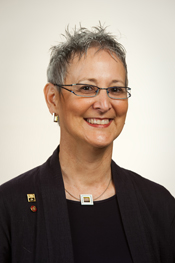April 27, 2012
Inclusion by design: Ornelas appointed to co-chair position of National Architecture Diversity Council
Submitted by Communications and Marketing

A Kansas State University professor is helping design strategies to increase the number of licensed female and multicultural architects throughout the U.S.
Wendy Ornelas, associate dean and professor of architecture at the College of Architecture, Planning and Design, was recently named a co-chair of the 2012 Diversity and Inclusion Council for the American Institute of Architects, or AIA. She is one of 13 individuals appointed to the council. The American Institute of Architects is a national association that offers education, advocacy and public outreach to promote the architecture profession. It has been active for the more than 150 years.
Together with co-chair Miguel del Rio, past president of the American Institute of Architects' Puerto Rico chapter, Ornelas will leverage the existing foundation work done by previous committees. The information gathered this year will measure progress and determine gaps so that the institute can develop strategies to increase multicultural and female architects' representation in the profession. Numbers and strategies will be passed to the local institute chapters, which can incorporate the information into their grassroots efforts to promote the profession.
"It is an honor to be asked to co-chair a committee on this important aspect," Ornelas said. "Right now it's hard to increase underrepresented groups because we don't really know where the architecture profession is in relation to women and multicultural individuals. There are enough things in place now that we can start making substantial efforts to increase the diversity in the profession."
According to the American Institute of Architects' internal 2011 demographics of its more than 79,000 members, 12 percent identify themselves as non-Caucasian. Similarly, 17 percent identify themselves as female.
One of the diversity challenges for the profession begins soon after women graduate with their degree, Ornelas said. A small percentage of graduates go on to become licensed, a mandatory certification needed before an architect can contract their services -- similar to designation medical professionals earn before seeing patients. When Ornelas was in school 7-8 percent of the licensed architects were women. Thirty-two years later, women make up 17 percent.
"A lot of it is that it's a long process to get licensed," Ornelas said. "You have to work for somebody for nearly three years and also take seven exams. This is simultaneous when women have babies and begin families, which makes it difficult to take that time off and then come back and get licensed. So one tends to get licensed before having kids or chooses to start a family and later try to get licensed. So the numbers have been really poor."
For underrepresented groups, the challenge often comes down to the profession having few role models from multicultural backgrounds, according to Ornelas. These professionals serve as a pipeline into the architecture profession for youth, introducing them to the field of architecture and inspiring them to pursue a career in it.
"From my experience, when I was looking at going into architecture I didn't know of any females or any underrepresented architects. As both a female and a Hispanic person, I didn't have anyone from either group who I could identify with," Ornelas said. "We know from other professions that having a diverse variety of role models helps to increase the number of underrepresented people in a profession. People see those prominent figures and think, 'Hey, that person's like me.'"
Ornelas discovered architecture after taking a career aptitude test in high school. She said the profession appealed to her because it incorporated a variety of subjects into a single discipline.
In addition to serving as the co-chair of the Diversity and Inclusion Council for the American Institute of Architects, Ornelas is also the regional director for the Central States Region of the institute. The region includes Kansas, Iowa, Oklahoma, Nebraska and Missouri. As a regional director, she is one of 53 people on the national board of directors of the American Institute of Architects. The board makes policy for the national organization.
She earned a bachelor's degree in architecture from California Polytechnic State University at San Luis Obispo and a master's in architecture from Oklahoma State University.
